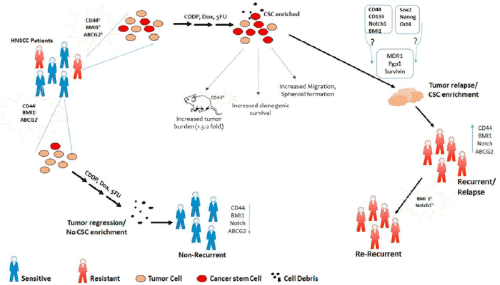
 |
| Figure 5:Cancer stem cells, Drug Resistance and Prognosis in HNSCC. The possible role of CSCs in the process of drug resistance is explained in the model. Increased expression of specific markers in the treatment naïve patients can indicate poor outcome; recurrence (CD44h/ABCG2h/BMI1h) or no recurrence (CD44l/BMI1l/ABCG2l). Combination chemotherapy on patients resistant to the drugs leads to an enrichment of the resident cache of CSCs in the resistant patients. These cells with an enrichment of CSCs have an increased self-renewal, migration and clonogenic survival with capacity to generate a higher tumour burden in SCID mice. These cells also showed an increase in CSC markers (CD44, CD133, Notch1 and Sox2-Oct4) and survival pathways (MDR1/PgP1/Survivin) suggesting that the possibility of a CSC-mediated drug resistance. These drug resistant CSCs ultimately lead to generation of more aggressive tumours and lead to a disease relapse in the resistant patients. In contrast, in the (CD44l/BMI1l/ABCG2l) cohort, combination chemotherapy does not lead to enrichment of the CSCs and is thereby effective in controlling the disease. |